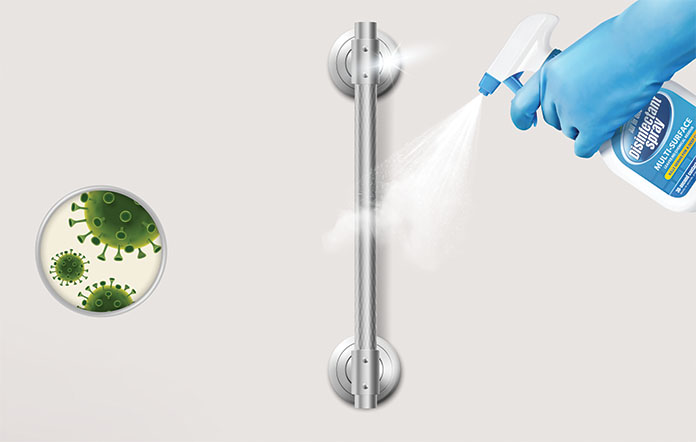The meaning of clean in the day of C19
Your leasing office and common areas are clean, but are they disinfected? Welcome to the age of microscopic traffic.
Counting incoming traffic was once done to analyze the quality of lead generation and the effectiveness of marketing channels. Today it’s more often done to manage people who come into the office in order to maintain numbers conducive to social distancing.
While the data around C19 ebbs and flows, upping the game on a disinfected environment is a practice that remains smart throughout the ages.
First public health revolution
U.S. life expectancy doubled to over 80 years in the last 200 years. Many attribute this to medical advancements. And while this is somewhat true, the largest jump in life expectancy occurred between 1880 and 1920.
It was during this time that improved sanitation, public water treatment, sewage management and municipal garbage collection nearly eliminated deaths from tuberculosis, pleurisy, typhus, tonsillitis, cholera and dysentery.
These changes in public health services are called the First Public Health Revolution, and happened before medical advancements like antibiotics. The Industrial Revolution (1750-1850) and Louis Pasteur’s germ theory (1861) together made hygiene and sanitization society’s first line of defense in the fight against disease and illness.
Cleanliness is a simple concept. If you walk into a leasing office, desktops, the counter, even the floor are obviously clean or not. Clean is the absence of visible dirt. But as Pasteur and those who followed showed, germs (disease-producing microorganisms) are a whole other battleground in the fight for health and well-being. Let’s first understand the differences between types of germs in order understand the products most effective in fighting them.
Germs include bacteria and viruses—they are not the same, nor are the medical protocols used to treat them.
Bacteria are single-cell organisms. Some are good like those in your digestive system. Others, if ingested, may reproduce and release toxins in your body making you ill—like a cold. Antibiotics effectively treat bacterial infections but are ineffective against viruses.
Viruses are made of genetic material—RNA or DNA—surrounded by a protective coating. Viruses can only live and multiply inside other living things.
Of the world’s 2,000 identified viruses, less than 10 percent infect humans. Even then the human body has defense mechanisms to fight and stop most viral infections.
Our bodies fight such invading organisms on a regular basis. The body’s first line of defense include skin, mucous and stomach acid, followed by our immune system.
When one’s immune system is unable to fight a virus, effective treatments sometimes are able to stop it from reproducing. The virus then dies out on its own.
Proper nutrition is a good way to keep one’s immune system strong enough to fight such invaders. A clean environment also keeps transmission and viral exposure to a minimum so that the body isn’t required to fight an incoming infection.
Cleaners
Soap and detergent will clean surfaces and remove dirt and germs. Important to note: While these cleaners remove germs—they do not kill them. The Environmental Protection Agency (EPA) neither tests nor regulates cleaners for cleaning effectiveness.
Disinfectants
As people go in and out of your office or common areas, new germs follow. Disinfecting high-touch surfaces—those surfaces that are touched multiple times a day like door handles or elevator buttons—kills viruses, mold, mildew and fungi. Sanitization adds a layer of community safety by eliminating the spread of viruses that may have been transmitted to a surface.
Disinfectants are regulated by EPA. To be certain that a product kills viruses, read the label. Not every cleaning product is a disinfectant, and most green products are not. The CDC (Centers for Disease Control) recommends using EPA-registered household disinfectants.
A simple homemade disinfectant can be created by combining one-third cup of bleach per gallon of water. Spray or wipe the solution on the surface to disinfect and let sit for at least one minute.
Alcohol also disinfects, but must be at least 70 percent alcohol. Alcohol pads are great for quickly disinfecting small items like your phone.
Disinfecting products work differently. It’s important to follow the directions on the product you’re using to disinfect your apartment, car, your space on public transportation or your office. Many products recommend leaving surfaces wet with the disinfectant for a specific period of time to ensure it works.
When disinfecting your office or common areas, prioritize high-touch surfaces. These are the most likely to harbor germs: doorknobs, faucets, tables, countertops, light switches, handles, desk tops, phones, keyboards, remotes, toilets and sinks.
Sanitizers
Sanitizers kill bacteria and are often used where food is prepared. The type of bacteria a product kills may be found on the product label. Both sanitizers and disinfectants are under the direction and review of EPA.
Dwell time is the time it takes for a product to kill respective germs. Some chemical formulas take as much as 5 minutes to work, while others kill germs in a minute or less.
The frequency of disinfecting should be increased with the level of area usage and health threats.
In addition to keeping public areas safe, maintain personal safety by keeping your hands away from your nose and mouth. Wash your hands for a full 20 seconds with soap and hot water each time you have used an elevator, opened a door or have touched other public spaces.
With every outbreak, we learn. C19 is no different. The key is keeping your resistance strong.
Historical perspective
- March 2024
- February 2023
- July 2022
- March 2022
- June 2021
- February 2021
- August 2020
- February 2020
- July 2019
- April 2019
- June 2018
- April 2018
- October 2017
- May 2017
- November 2016
- June 2016
- November 2015
- June 2015
- September 2014
- June 2014
- April 2014
- December 2013
- July 2013
- December 2012
- July 2012
- October 2011



